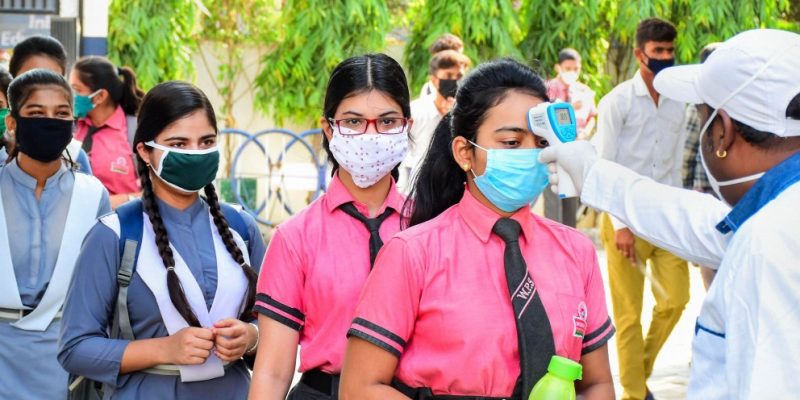Lockdowns to contain the spread of the COVID-19 pandemic have posed many challenges for school education globally, and India is no exception.
The COVID-19 pandemic, due to its unprecedented scale and unique response strategies, has had a critical impact on children’s education, particularly of those from marginalised sections. Besides the disruption in the school year, there is a risk that prolonged out-of-school learning may lead to alienation of children from school systems and exacerbation of existing inequalities. We could see disruptions in continuity of schooling for girls and children of those who migrated back from urban to rural areas after losing livelihoods, post the abrupt imposition of the lockdown.
The extent of impact of the lockdown on schools, community and children is proportionally very high. India has 1.4 million schools, 2.01 million children enrolled in government schools from Standard 1-8 and an additional 3.8 million children enrolled in Standard 9-10, according to the Udise report on school education in India, 2016-2017. Approximately 29% of India’s population are children, and 19.29 % is in the age group of 6-14 years. This group is legally entitled to education under the Right to Education (RTE) Act, 2009.
India’s multilayered society has always needed a strong public education system incorporating a holistic vision to achieve universalisation of education while also establishing a discrimination-free education system. However, this didn’t receive adequate attention from policy-makers. Now, the pandemic has magnified inequalities like never before.
Previous health emergencies also demonstrate that the impact on education is likely to be most devastating in countries where there are already low learning outcomes, high drop-out rates and low resilience to shocks. Despite increase in public awareness and aspiration to get children educated, as well as increased enrolment of children in schools post RTE Act 2009, India’s learning crisis remains grave. The Delhi-based ASER Centre’s Annual Status of Education reports and many other sources have highlighted this time and again. The National Sample Survey of Estimation of Out-of-School Children report submitted to the ministry of human resource development in 2014 revealed that 6 million children were still out of school.
Also read: Here’s How We Can Gear up to Open Schools After the Lockdown
A look at previous emergencies in the country reveal direct and indirect impacts of natural disasters on school education. Direct impacts include destruction of school buildings and damage to roads connecting to schools, resulting in uncertainty of reopening and irregular attendance. Indirect impacts include long-term closure of a school due to temporary conversion of school building to a rehabilitation centre, silent exclusion of children belonging to families in distress through displacement or migration, resulting in child labour, child marriage and child trafficking, a 2017 study by Azim Premji Univeristy found. But resilience is still not a development priority in India as 76% of the 100 smart cities, including Delhi, lie in zones that are at medium to high risk of floods, earthquakes and winds or all three, according to an essay in Disaster Risk Governance in India and Cross Cutting Issues, edited by Indrajit Pal and Rajib Shaw, 2018.
Retrofitting schools and other institutions like hospitals comes with a cost post-disaster, according to the same book. It is astonishing that dialogue between different stakeholders on building a Disaster Risk Reduction (DRR) plan is still not a development priority in India, finds the book. Even though COVID-19 is different from previous emergencies on many counts, it is disturbing to see no preparation despite its outbreak in China in the two months before it fully hit India. The lack of resilience and a DRR approach in the country will lead to catastrophic outcomes, some of which are already becoming visible.
The National Commission for Protection of Children Rights (NCPCR), which is the primary monitoring agency of the RTE Act 2009, has seen a huge swell in the number of complaints it has redressed before the lockdown. In the previous year, the NCPCR addressed around 5,000 complaints; post-outbreak (beginning March 2020), this has increased about 8-fold.
School teachers have also been impacted immensely. India’s school education system includes 10,93,166 contractual teachers at the elementary level. Delhi alone has approximately 29,000 such contractual teachers. These teachers, in many states like Bihar and Delhi, were not receiving their salary for several months even before the pandemic broke out.
Also read: DU Should Cancel Open Book Exams, Spare Students of ‘Final Cuts’ of Trauma
The coming of the pandemic has made their situation bleaker. Delhi government orders show that contracts have been extended only till the announcement of the next vacation (May 11-June 31, 2020), without any mention of the rest of the year. This has made contractual teachers uncertain about continued employment. Despite all these difficulties, teachers are playing a significant role during the lockdown. Wherever schools have been used as a relief distribution centre, all teachers irrespective of position are providing services from morning till night. In Delhi itself, ration and relief is being distributed in more than 250 schools. If any contractual teacher is not providing services, they are not getting paid at all.
Lack of infrastructure in schools is another major challenge in these COVID times, which will impact continuing school education. The RTE Act brought a normative framework to ensure quality and equity in elementary education. However, even after 11 years, less than 12% schools are RTE-compliant. Lack of safe drinking water, toilets, hand-washing facility, electricity and cramped classrooms means schools don’t have the prerequisites to reopen. Further, due to closure of many government schools in several states, as part of a consolidation policy, numerous government primary schools do not fall within the RTE Act requirement that they lie within 1 km from the habitation of all students, which also forms one of the basic principles for reopening schools.
Lack of schools, infrastructure and teaching and non-teaching staff including sanitation workers will impact children’s education immensely, during and post-COVID. Further, participation of community, school management committees and local institutions needs to be increased so that local needs and voices are well-represented. Physical distancing, sanitisation and other guidelines for prevention of infection, should be strictly followed for their safety and of others.
Schools are more than learning centres for poor children. They provide social protection, nutrition, health and emotional support to the most disadvantaged, and this applies in all countries, from low- to high-income. About 9.12 crore Indian children are not receiving their mid-day meal during school closure. These meals served as an important safety measure, as economists estimate that 75% of poor families’ income is spent on food. Further, lawyers have written to the Chief Justice of India to take sou moto notice of rise in cases of child abuse during the lockdown, which highlights that school also acts as a safe space for many children even today.
The big changes to school education in the COVID-19 scenario that the government has announced – digital and online education, attendance of 30-40% children after reopening of schools, subsidy to private schools, to name a few – is another concern which will have a huge impact on children coming from vulnerable sections. National Sample Survey Office 2014-2015 data clearly shows economic factors as key to children dropping out of school.
Also read: The Pandemic as an Opportunity to Educate on What it Means to Be a Citizen
The pandemic and lockdown has impacted 14 lakh migrant workers as well as others working in the unorganised sector (90% of India’s population is engaged in unorganised work). It has impacted the poor adversely across the globe. In such a situation, blatant emphasis on technology-driven education will exclude many children in this country from continuing school education. Besides infrastructural challenges, India is a diverse and multilingual country. Various dialects, various contexts and diverse lived experiences are what a classroom in India brings together. The one nation, one channel or one digital framework needs to be reconceptualised to ensure equity and quality in education.
The return of children to schools in the above circumstances will bring a new normal, set by the outbreak of the pandemic. Social policy and response during the pandemic will mark the lives of children. On one hand, the school ‘space’ was used for the benefit of the whole community/‘public’, blurring the gaps between the community and school, and on the other hand community participation was reduced by social/physical distancing and limited movement from the close precincts of homes. On one hand, the country came together on several occasions to show solidarity and, on the other, fellow villagers were attacked in their own village after painstakingly reaching home, often on foot.
In this ‘new normal’, changed behaviour of people and changed centralised norms and guidelines could lead to a situation where forms of governance and participation may change. Virtualisation of teaching may impact the social relation between peers, teachers and school and community on the whole. The social class gap between the teachers and students may widen after the school reopens post-lockdown. What would be the everyday experience of children and their response to these changed realities?
The latest Draft New Education Policy (DNEP) 2019, being finalised since long, certainly requires revision in this context. If the ‘new normal’ becomes the norm, the policy will need to situate equity, inclusion and diversity in the new frame of things. A one nation, one channel or one digital framework will not be able to translate the goal set by the DNEP into action. Further, this will also create barriers to India achieving the Sustainable Development Goals (SDG), particularly SDG4 on quality education, which now ever more than before needs to be looked at along with SDG1 (no poverty) 2 (zero hunger), 3 (good health and well-being), 5 (gender equality), 11 (sustainable cities and communities) and 17 (partnership for the goals).
Also read: Is Social Distancing Feasible for a Majority of Schools in India?
The DNEP requires revisions to address the following concerns: Strengthening of the normative framework of the RTE Act instead of restricting it; access, equity and diversity of language and lived experiences so that all children are well within the school education system; trained and permanent teachers whose agency is recognised; adequate resilient schools and infrastructure; and, most importantly, participation of local authorities and community so that children coming from vulnerable families, particularly SC/STs, Muslims and girls are not left out.
This will also prepare school systems to face such pandemics in the future more efficiently and without prolonged disruption, as well as move towards building a strong public education system in the country. COVID-19 did teach us how schooling is not equivalent to merely learning, but encompasses a social space, a social process, to learn to live, think and act for one’s self and the collective good.
Aparajita Sharma is assistant professor, Council for Social Development, and a Right to Education enthusiast.




